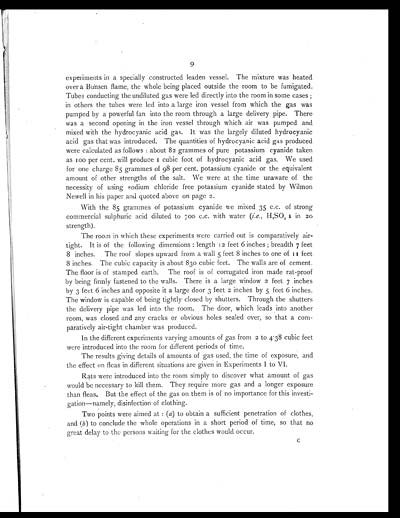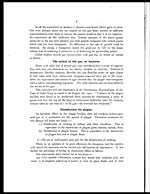Medicine - Institutions > Army health reports and medical documents > Scientific memoirs by officers of the Medical and Sanitary Departments of the Government of India > Number 38 - Preliminary report on the killing of rats and rat fleas by hydrocyanic acid gas > Preliminary report on the killing of rats and rat fleas by hydrocyanic acid gas
(17) Page 9
Download files
Individual page:
Thumbnail gallery: Grid view | List view

9
experiments in a specially constructed leaden vessel. The mixture was heated
over a Bunsen flame, the whole being placed outside the room to be fumigated,
Tubes conducting the undiluted gas were led directly into the room in some cases ;
in others the tubes were led into a large iron vessel from which the gas was
pumped by a powerful fan into the room through a large delivery pipe. There
was a second opening in the iron vessel through which air was pumped and
mixed with the hydrocyanic acid gas. It was the largely diluted hydrocyanic
acid gas that was introduced. The quantities of hydrocyanic acid gas produced
were calculated as follows: about 82 grammes of pure potassium cyanide taken
as 100 per cent. will produce I cubic foot of hydrocyanic acid gas. We used
for one charge 85 grammes of 98 per cent. potassium cyanide or the equivalent
amount of other strengths of the salt. We were at the time unaware of the
necessity of using sodium chloride free potassium cyanide stated by Wilmon
Newell in his paper and quoted above on page 2.
With the 85 grammes of potassium cyanide we mixed 35 c.c. of strong
commercial sulphuric acid diluted to 700 c.c. with water (i.e., H2SO4 1 in 20
strength).
The room in which these experiments were carried out is comparatively air-
tight. It is of the following dimensions: length 12 feet 6 inches; breadth 7 feet
8 inches. The roof slopes upward from a wall 5 feet 8 inches to one of 11 feet
8 inches. The cubic capacity is about 830 cubic feet. The walls are of cement.
The floor is of stamped earth. The roof is of corrugated iron made rat-proof
by being firmly fastened to the walls. There is a large window 2 feet 7 inches
by 3 feet 6 inches and opposite it a large door 3 feet 2 inches by 5 feet 6 inches.
The window is capable of being tightly closed by shutters. Through the shutters
the delivery pipe was led into the room. The door, which leads into another
room, was closed and any cracks or obvious holes sealed over, so that a com-
paratively air-tight chamber was produced.
In the different experiments varying amounts of gas from 2 to 4.38 cubic feet
were introduced into the room for different periods of time.
The results giving details of amounts of gas used, the time of exposure, and
the effect on fleas in different situations are given in Experiments I to VI.
Rats were introduced into the room simply to discover what amount of gas
would be necessary to kill them. They require more gas and a longer exposure
than fleas. But the effect of the gas on them is of no importance for this investi-
gation—namely, disinfection of clothing.
Two points were aimed at: (a) to obtain a sufficient penetration of clothes,
and (b) to conclude the whole operations in a short period of time, so that no
great delay to the persons waiting for the clothes would occur.
C
Set display mode to: Large image | Zoom image | Transcription
Images and transcriptions on this page, including medium image downloads, may be used under the Creative Commons Attribution 4.0 International Licence unless otherwise stated. ![]()
| Permanent URL | https://digital.nls.uk/75033598 |
|---|
| Shelfmark | IP/QB.10 |
|---|---|
| Additional NLS resources: | |




